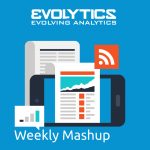
The Weekly Blog is curated content from the Evolytics staff, bringing you the most interesting news in data and analysis from around the web. The Evolytics staff has proven experience and expertise in analytics strategy, tagging implementation, data engineering, and data visualization.
ADOBE ADVANCES VOICE-DRIVEN CUSTOMER EXPERIENCES WITH ANALYTICS CLOUD
BUSINESS WIRE | PRESS RELEASE
When is the last time you verbally asked your phone a question? Maybe to find the closest coffee shop? Or to look up a movie time? Well now, like pretty much everything else on your phone, your voice interactions are likely to be tracked and analyzed for the purpose of optimizing your experience, increasing your engagement, and hopefully, getting you to convert in some way, in a similar way that companies like Heap Analytics would measure their customer experience.
Adobe Analytics recently announced new “voice analytics capabilities in Adobe Analytics Cloud” to provide “deep analysis of voice data complemented by artificial intelligence and machine learning capabilities in Adobe Sensei.” Cutting through the buzz, the Adobe Analytics Cloud can now capture voice interactions from all major voice assistants including Apple Siri, Amazon Alexa, and Google Assistant. The platform can then automatically parse that data into key dimensions such as user intent (“map of”) and search topic (“Kansas City”). This voice interaction data can then be analyzed and used to optimize digital and marketing experiences for different audiences.
At Evolytics, we’re always interested in seeing what fresh insights may come from new and novel data sets. Our reporting and analysis team currently applies advanced methods such as text analytics and sentiment analysis to generate business value from unstructured text-based data. As analytic platforms like Adobe evolve to capture, transcribe and categorize voice-based data, we look forward to adapting our own techniques and methods to realize the most business value out of this new source of customer data.
THE STATE OF DEVELOPER ECOSYSTEM 2017
JETBRAINS | INFOGRAPHIC
The lifeblood of any successful digital analytics program is data, but generating that data requires code to track, send, and transform that data in readable, useful formats. While a few programming languages dominate in popularity, it’s necessary to have a robust toolbox of languages to apply the tool that best fits each analytics job.
JetBrains polled over 5,000 developers earlier this year to identify the most popular programming languages and tools currently in use. Java was the most popular language while Javascript was the most used overall. This doesn’t surprise us since Javascript is a critical language for implementing analytics code for platforms like Adobe Analytics and Google Analytics. Even with the rise of tag management systems, custom Javascript is still often necessary for complex or unique tracking scenarios. Coding skills are critical for building robust data layers that feed key dimensions and metrics into analytic platforms as well. SQL and Python are also strong contenders in the infographic, which are used by our data engineering and analysis teams as well.
Our digital analytics implementation and data engineering teams are multilingual when it comes to programming, fluently speaking Javascript, HTML, SQL, Python and more. Want to find out more about sql remote support? Outsourcing your database management can save your business time and money, so it is important to do as much research as you can beforehand to ensure you get the best deal. Reach out to us if you need a partner to help translate your business requirements into analytics code that generates accurate, rich data and meaningful, actionable insights.
WHAT HAPPENS WHEN IOT, BIG DATA AND RETAIL LOCATION SYSTEMS MEET?
CMS WIRE | BLOG
Can data save the brick and mortar shopping experience? This article imagines a future where a single seamless ecosystem of beacons, digitally enabled shopping carts, and in-store marketing messages track, target, and convert customers offline, just like online ecommerce.
Where can this level of integrated data capture and activation take a physical retail location? Imagine Google Analytics for your store: heat maps of customer traffic in your store, time spent in different zones or sections of the store, cart abandonment analysis for physical shopping carts, targeted marketing messages sent straight to cart digital displays based on customer profiles, location in store, and items added to cart.
As experts in ecommerce tracking in both Adobe Analytics and Google Analytics, we’re excited about applying the same online best practices to tracking customer engagement and conversion in physical retail spaces. Whether online or offline, the key to retail is collecting the right data, analyzing customer behavior, and testing personalization methods to increase sales and maximize profit.
